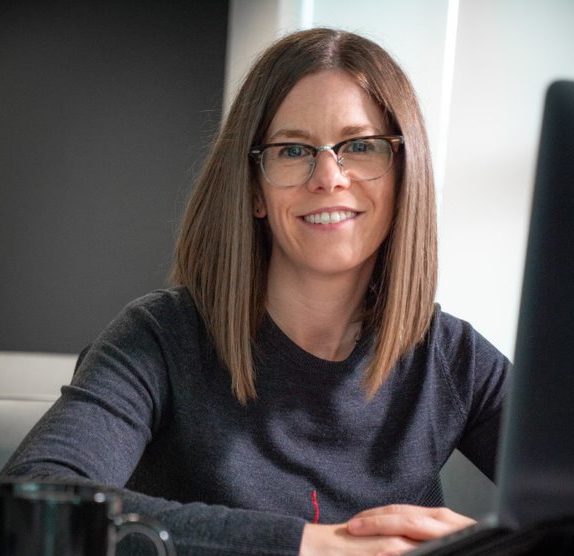Rupal Thanawala is a blazer of many trails. She was one of the few Indian women working in IT in the 1990s. Her parents never finished elementary school and she wasn’t able to rely on them for direction.
After more than 20 years in tech, she continues to use her knowledge and influence to help others around her: women entering the workforce, and other historically oppressed groups that see an opportunity in tech.
Rupal Thanawala is the Managing Partner of Trident Systems and the Tech Editor for the Indianapolis Recorder.
How things have changed since the 90s and early 2000s
As a veteran IT consultant since the 90s, Rupal says technology was very different back then—it was limited to just a few applications and widgets. The world was driven by technology but it was never as rampant and innovation-driven as it is today. She says today, technology has become an enabler and is embedded in every part of the business.
As a woman in leadership, she says workplaces have not reached a high level of acceptance towards women. Coming from a culture that had very few women in engineering, Rupal says she did not have access to resources to help her afford a college degree. And even though her parents were supportive of her ambitions, they did not know how to mentor her. And she says this motivated her to mentor students and women particularly, in their college careers.
Mentoring young women
Rupal says young women need to find their role models. It’s not always going to be easy to find role models to look up to but she says they need to “look outside and dream about it. Because you can only have a reality if you have dreamt of it.”
But women need to know what the possibilities are. They need to be guided on career options, the economic and personal impacts of getting a college degree, and how they can make it a reality.
Mentoring women in their careers is a cycle that goes beyond giving them advice. Great mentorship also requires coaching and networking. As a mentor, she says a lot of women are dropping off mid-journey because they may not have access to the right people or job opportunities. And they fall back on jobs or careers that are offered to them.
Students of technology
Rupal says leaders need to be students of technology. They need to shift their mindsets from seeing digital transformation as a strategic initiative and start thinking of it as mandatory disruption. Digital transformation, she says, is an integral component of every business function and companies risk becoming obsolete if they do not adapt.
CEOs and founders need to put trust in their CIOs. Rupal explains that while CEOs focus on delivering value to shareholders, extending their customer base, and improving team productivity, CIOs can help them embed technology across the business and remove inefficiencies.
Links
Quotes
9:33 – “I ask them to find a role model. It’s not always going to be easy for them to find (role models) in their families. So look outside and dream about it. Because you can only have a reality if you have dreamt of it.”
13:30 – people still think it (digital transformation) is a strategic initiative but it is mandatory disruption. Because if you do not adapt yourself, enable your organization, and advance, you could be obsolete.”
Today, our guest is Rupal Thanawala. She is the managing partner of Trident Systems and also the tech editor for the Indianapolis Recorder. Hi, Rupal. How’s it going today?
Great. How are you doing?
Excellent. I’m really excited to talk to you. I’ve seen your name in so many places, we’ve had a few conversations ahead of time. But this is just fun to be able to sit down with you and have a chat.
It’s my pleasure.
So let’s start off with our checking round question. Just to prove your humanity, I’m going to ask you what have you changed your mind about in the last six months?
The last six months have dramatically changed the way we work. But personally also how do I manage my team and how we can be more empathetic and compassionate with our employees. It’s been very different time for us as leaders, but then also for employees where we are really lacking human interactions. And of course, every individual is dealing with a whole lot. And probably more than they had expected in a very short time. So what has surely been important for me as a person is that how do we draw the line between our working hours and our personal hours. And of course, that being, of course, shared with our people. Also, having a different workplace versus your family place, making sure that you have a separate workplace in that way. We can fully focus when you’re working. And also importantly, understanding that people’s workplace looks different. That means we have asked moms to work from home and dads also. So yes, they’re parents, their children, their daily chores, are going to be integrated within their work environment.
It’s always nice to see the children come on Zoom calls and different things like that. And just for that to be normal now and not something to be embarrassed about.
Absolutely. So I really encourage people that it’s okay, and don’t, just, shh, I’m in a conference call. No, let’s make it normal. Because it’s very hard. It’s not just a one week, two week type of a setup. We have been in this one for more than 10 months now. So, be human, I think that’s most important. And as a leader, it’s very important for us to understand that we have, as leaders, challenged our workforce to change their place of work. We have changed their daily routines. We have practically invaded in their family life. So be understanding about what we have done to our people. And I think that’s one thing was the biggest change is even for me to adapt and make sure that I’m understanding my people’s daily life, and I’m not over exposing myself to them, and give them the space that we best can.
Yeah, being aware of that is great. Rupal, you have a really fascinating history. And I think one that’s going to serve this conversation very well. So why don’t you give us just a quick background of the last 20 years that you’ve spent in this business and IT strategy world just to give a framework for this conversation.
So I have been for most of my career into the IT consulting space. Although I started as a biomedical engineer and an entrepreneur. But since I have been in the US for the last 20 plus years, I have always stuck to that and worked in different big consulting firms. BearingPoint, which was a KPMG IT consulting business, then PwC, Accenture. But then I’m also right now working for my own consulting firm. But throughout my journey, I have always maintained my giving back work on that means I’ve been on multiple boards. I’m the president of Asian American Alliance. I am very involved with the Black Data Processing Associates, which is called BDPA. It’s a national organization. And I’m very much involved with the Indianapolis chapter. And being very much involved in my children’s life and then now I mentor young adults on the journey to college.
I’d like to get your input on, as you’ve seen changes in the workplace, you’ve seen things I would say at the height of those KPMG days, seen how businesses operate. In the midst of seeing all these digital things happen, the big wave of tools coming forward, as you look at what’s different today versus then, let’s just start off with the topic of digital leadership, when you look at the leaders who are in place, trying to lead teams through these times, compare and contrast what it looks like for a leader today in 2021 versus maybe back in the early 2000s, or in the 90s.
Sure, so I think I may sound a little dated to your audience. But I started my journey when we were programming on MUP 8086 chips, which probably nobody knows what I’m talking. So we started on those days. But at the time, I think technology was, of course, in its infancy. And it was very limited to just a few applications. We were even excited that we got an email, or I remember my Y2K days when we were worried that oh, the world is going to end and the flights will be shut down and there won’t be any electricity on January 1 and all. But then it was a very hardcore technology driven world versus the way I see now in today’s day, technology has been truly an enabler. I see no true innovation in last few years versus in my early days, it was a more like, hey, can we just put some widgets here and there? I think now I feel, okay, this is called real innovation and such that technology has been embedded in every part of the business now.
So when you think back to those early days, especially, I’m going to ask you, as a woman working in that space in the early days, did you find it difficult? Or was the technology space a little bit more progressive than other areas?
I think we are still not that progressive. So I think that’s a very valid question. My answer, of course, you can predict is that, yes, it was very different. Particularly I graduated from India, and there were very few women, even in engineering school to start with. I was one of the very first biomedical engineers in my small school.
Did you have a lot of support from your family to do that?
I would say no because in my family, I’m the first generation college graduate. My parents didn’t even finish elementary school. And I didn’t have many resources in the days that I could even afford a college degree. So I would say, I had a supportive parents. However, they didn’t even know how to mentor me, guide me, or support me the way I wanted. So it was very different. Plus women did not work outside home in my family. Women did not go to college, for that matter. And the ultimate goal for women was you get married and start your family and take care of your family. So, although my parents wanted me to do what I wanted to do, but they were really struggling is, what are you talking about? We don’t understand what you want to do? So I’m grateful for my parents for allowing me to do what I wanted to do. But one thing I always, that’s one of the reasons I mentor a lot of students for college careers and finding the right college and all, because often parents do not understand how to guide their children.
As you are a mentor now to several people as it’s coming through, specifically women, what are you telling them today that you wish you heard back then? And how have you also changed your advice and the way that you help people in this time?
And this is a perfect week, because we had our very first woman Vice President elected also that it’s possible.
Did it always feel like, even before something like that, it was like, we said it was possible, you can be anything you want. But without those role models, do women really believe that as they’re coming on?
Absolutely. So I want to be their role model and I ask them to find a role model. It’s not always going to be easy for them to find in their families, like it was not easy for me to find one in my family. So look outside and dream about it. Because you can only have a reality if you have dreamt of it. And at the same time, explaining to them what all is possible. I think it’s a very empty statement to tell somebody, hey, it’s possible unless you don’t know what are the possibilities. So having a very organized mentoring to the young woman is very important. What are the career options they have? What does it take to go to a college? How does it change your economic and family dynamics once you have a college degree? And I think making it real for them, like it’s more of a show and tell is needed than just lecturing them. So I’ll give you one example. I had a young woman who wanted to go to an Ivy League school. And she came to me and she had a few college admissions, but that was not fully funded, and she could not have afforded. And she was almost going to give up on her application. And I said, look, you have to just apply for these scholarships. And particularly, in some of the schools, they have scholarships for women in STEM. And she said, oh, I didn’t even know about it. And I said, if you take this career path, she wanted to be in agriscience. And I said, if you’re in agriscience, and Indiana has this many jobs published on it, look it up. And she said, oh, yeah, now I can imagine how it can be from dream to reality.
So I think holding that hand throughout the journey is more important. I often see so many young women going through different conferences and really feeling very energized and encouraged that, yes, I want to do it, but often they really lack, how do I do it? There are so many STEM focused high school programs nowadays, which is great. So many STEM programs out there, Eleven Fifty Academy has so many available, people can just go and take the courses there. So I think giving them the tools to be successful is more important, of course, to ignite them and think about it is absolutely needed, because often not every woman gets that. But then taking them through the entire journey is very critical. Even once they get through it. They go to an Ivy League program or women in high tech program. These are the jobs available. Hey, how can I connect you with the right person? Networking, mentoring, coaching. So it’s a complete cycle. Or else we are dropping a lot of women in between this whole journey. People say, oh, I was frustrated because I didn’t know anyone to ask a question. I found it so hard to even find a job. And I rather fall back into my whatever career that probably was there offered to me, and I’ll fall back on that. So I think that is what is missing. And that’s what I tried to provide them.
Yeah, that’s fantastic. Let’s talk about the leadership role and what it means to be a digital leader today. What do you feel like are the things that digital leaders in the present day, what are the skill sets they need to build into? How is their role different than it was 20 years ago? How would you advise people in that situation?
So number one thing is, digital transformation, in few days, it was more of a strategic initiative, people still think it’s a strategic initiative, and it’s in my mind also, but it is truly a mandatory disruption. Because if you do not adapt yourself, enable your organization and advance, you could be obsolete otherwise. So changing that mindset is very critical. And making sure that digital transformation is part of every business, every part of the business you have. Like, very early on, I think technology was very relevant only in manufacturing. And that is where probably a lot of new tools and technology started coming. I worked in SAP for many, many years. And that’s where all it started, supply chain, because that was easy to do. But now it is in every part of the business. And every leader have to be digitally literate. And one more thing I would say is be a student of technology. As you could be a CFO, you could have been a CFO, CEO, HR leader, you may not fully understand all the tools and efficiency that you can gain from digital transformation.
So what does it look like for someone to be a student of technology without having to learn programming?
I don’t mean to say that the anybody has to learn programming, what I mean is hire talent. I think having that trusted advisor as a CIO is absolutely a person that you need in your executive team. Listen, that’s what I mean, adapt and listen, it’s very important. Because I know every leader is looking few things by end of the day, what is the shareholder value that I’m able to give the value to my shareholders? How am I gaining efficiency? How am I extending my customer base? How am I going to change as a CFO? What’s my bottom line? Which places you have inefficiencies that technology can remove? So be open minded. I think when I meant student, be open minded and listen to the ideas.
And I find that it’s important as well for when leaders that are thinking about technology, sometimes they think about it as a separate department, like that’s what the CIO does. But then there has to come a moment when you realize that technology you’re adding is changing the rest of the organization, too. It’s changing the way that your culture happens. It’s changing the way that you collaborate. It’s changing the way that you lead the people around you. And not just seen as, that’s what the CIO does. That’s what the tech people do. They add this technology in. But actually, it’s infecting, maybe it’s not the right word, but it’s impacting everything else that’s going on, too.
Yeah, absolutely. And I think, this is the mindset of leaders who were probably there 20 years back, and they’ve done outstanding job in whatever they were doing, whether in the finance, sales, marketing, HR chart, and I don’t want to put them in pigeon holing anyways, but that’s how they saw that, hey, only business knowledge could get them here. Because those days, they did not see technology as an enabler, rather they looked at technology as a widget, versus now it’s embedded across the business. And that is what your competition is doing. And that is what I mean by adapt, enable and advance, or else you will be obsolete. Because if you’re not paying attention, then your competition is going to move faster than you.
I love that idea of seeing it as beyond just a widget. It’s part of the internal operating system of your company, how you work is your approach to technology. Do you have any stories about leaders that you’ve interacted with that have either done this really well? Or have failed to do it? And what happened to them in that experience?
I think I’ve seen both sides of the story. So yes, I have seen the leaders who have failed, and I don’t want to put any known person in that thing. But I would say the story about Blockbuster versus Netflix is a great example. Blockbuster thought that the consumer behaviors change, and everyone is a consumer of technology nowadays. And that’s what happened with Blockbuster and Netflix, far bypassed them to the point that Blockbuster, probably my kids don’t even know what Blockbuster I’m talking. Or Kodak is another classic story. They couldn’t see the digital photography coming up, and they got absolutely wiped out. So, I think these are, I would say, the stories that probably, the companies that did not, could not see, and did not understand the power of digital transformation. I think but in a personal as a consultant, of course, we see this all the time. And, of course, I cannot talk about my clients here, but I think that’s what’s been happening. So I think that a few things that, at least when I talk to my customers, I talk about this five solutions that they absolutely, absolutely have to think about. The first one is communication and collaboration, and it does become even all the more important in 2020. People don’t walk down to each other’s desk. Your workforce is global. So, please implement the collaboration and communication tools. And your younger workforce communicates anyway very differently. I have my children telling me, Mom, we don’t pick up the phone and talk. There are just so many ways how people want to communicate, but so is your customers. So think about how we are going to collaborate with them. So, 2020 has, of course, accelerated that whole communication and collaboration to the next level. So even if you thought, yes, we’ll get on the bandwagon, you need to, if you have not channeled on that, then you have already missed the opportunity. Cybersecurity, with everyone bringing your own device and working from different places, and technology advancing so has advanced the threats to your infrastructure. So cybersecurity, you don’t need a one person who is just resetting your password anymore, but it’s far, far deeper than that. I would highly say that it’s not just CIO that you need in your executive boardroom, but then you also need your CISO. Do not underestimate that.
Cybersecurity, for a lot of the companies that we interact with, is like flossing your teeth. It’s like everyone knows, yeah, I should be doing that. That’s a good idea. But they just maybe don’t get around to it or feel like it’s out there. It’s a little bit too confusing. So that’s a great thing. And it’s great to pass on some good tips on that area.
The third one is cloud solution. I think we’re so used to, again, in a physical environment, that, hey, I go to my office, that’s a physical space. And I have my own desktop, and everything has been on my hard drive and all, but it’s beyond that now. It’s not just having your data on the cloud, but enabling so many cloud solutions that are available, because that’s another, I would say, again, it’s not only the efficiency, yes, but efficiency in terms of getting your work done. I had one client, I’ve worked a lot in life science industry, and one of the clients, their biggest challenge was when they get questions from FDA for the approvals, and it was a smaller client. And they said, we didn’t realize that having our data on cloud and collaborating with our different partners was so critical that they could put down literally three weeks from the response to FDA, by the way, what we have seen in 2020, that people get emergency approval and all and now these people are more aware of the lingo that goes on, hey, it’s in the clinical trials, and stage one, stage two, stage three, but typically, a drug approval process takes years. And it goes, like, you literally play volleyball with FDA, and so things like that. So I think cloud solutions has the power to accelerate your business. The fourth one I want to talk about is different business operations. And I did step on that a little bit. But that is your HR function, sales and marketing, finance. It’s not only just from enabling them in your business operations, but then how do you actually enable your data analytics and reporting? That is very critical.
Yeah, seeing how it’s integrated with everything else. That’s good.
Absolutely.
Now, what’s the last one?
And my last one is social media. I know it has got a lot of bad press recently, but that is where you have to listen. Because that is where your customers are talking about you. That is where the customers are learning about you. That is your direct way to be in touch with your customers. If you are tapping into a particular customer segment, then you absolutely have to have a social media presence. I know so many companies, they still do not have even their social media presence and you’re missing out on marketing, social listening, and so many other opportunities. So depending on, of course, the size of the company, have your in all like digital marketing experts for yourself.
Makes a lot of sense. Rupal, this has been great to think and to learn from you and everything you’re doing. I really admire who you are and how you’ve adapted your career over the years, not only in building more leadership roles and doing more consulting, but just the work you’re doing around, like you said, mentoring younger women, you’re doing a lot of work in the community around overturning antiracist policies and trying to bring more awareness to some of the discrimination that happens there. So, I really love talking to you. It’s been great to learn from you.
It’s been a pleasure speaking with you.
Thanks for coming on. We will be sure to stay in touch because there’s a lot that we can learn from you and everything that’s going to come through. So thanks for being on the show. We look forward to talking to you again.
Same here. Have a great day.
Rupal is a visionary and goal oriented IT executive with a track record of planning, developing and implementing cutting edge solutions in Fortune 500 corporations. She has over 20 years of business and IT strategy execution experience in ERP with demonstrated success in delivering innovative technology solution and skilled in all the phases of the project life cycle, from initial feasibility analysis, budget management , conceptual design through implementation and enhancement in regulated industry. She has assisted her client to develop short term and long term strategy for Serialization and track & trace to meet the regulatory requirements globally. Her entrepreneurial and customer centric approach resulted in gaining high ROI, cost effective and state of the art solutions.
Rupal had additional responsibilities of Sales, Vendor and Customer management, Project Delivery and People development. Rupal holds BS in Biomedical Engineering from Mumbai University and Executive MBA from Northwestern University Kellogg School of Management.












